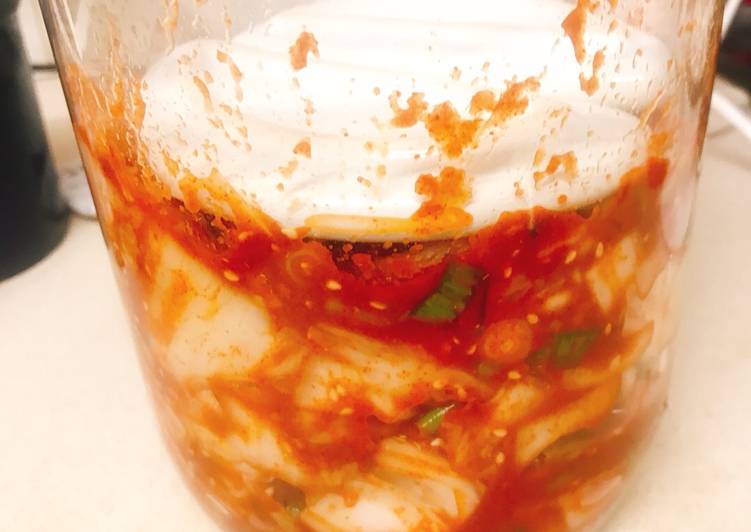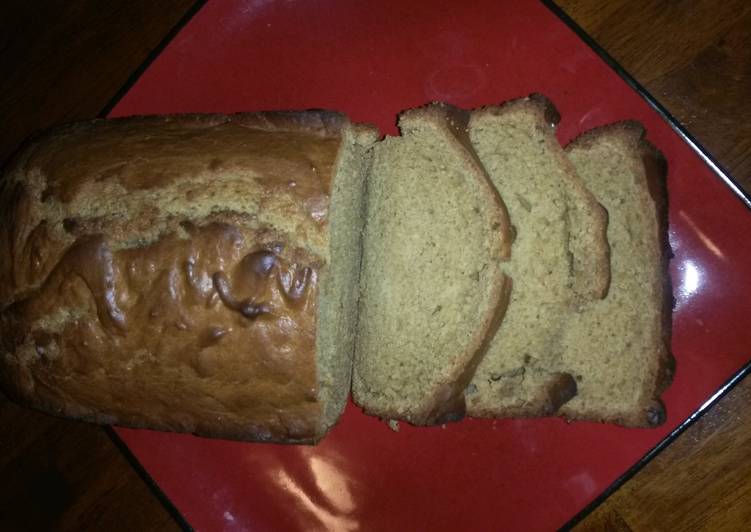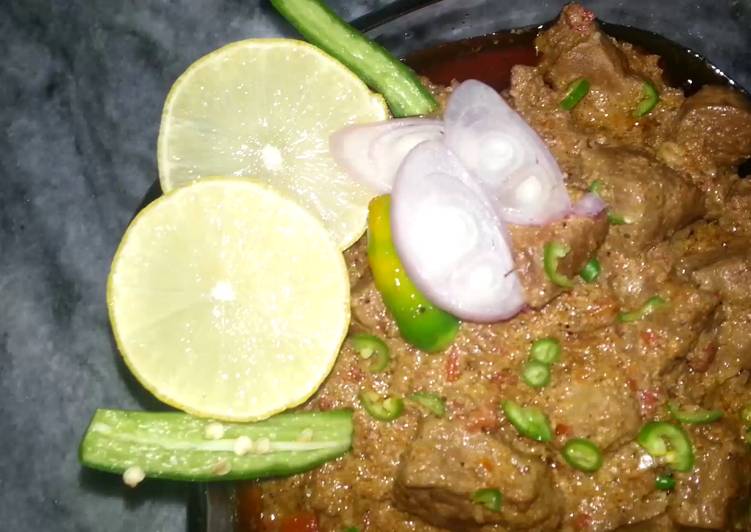
Hello everybody, it’s Louise, welcome to my recipe page. Today, I’m gonna show you how to make a special dish, kimchi. It is one of my favorites. For mine, I’m gonna make it a bit tasty. This is gonna smell and look delicious.
Mak kimchi, or simple kimchi, is made with cut cabbage, radish, and scallions and a seasoned paste of red pepper, garlic, ginger, sugar, and fish sauce, salted shrimp, or kelp powder. (Image credit: Apartment Therapy ) Kimchi (/ ˈ k ɪ m tʃ iː /; Korean: 김치, romanized: gimchi, IPA: ), a staple in Korean cuisine, is a traditional side dish of salted and fermented vegetables, such as napa cabbage and Korean radish, made with a widely varying selection of seasonings including gochugaru (chili powder), spring onions, garlic, ginger, and jeotgal (salted seafood), etc. It is also used in a variety of soups. Get Kimchi Recipe from Food Network.
Kimchi is one of the most popular of recent trending foods in the world. It is appreciated by millions daily. It is easy, it is fast, it tastes yummy. They are nice and they look wonderful. Kimchi is something that I’ve loved my entire life.
To begin with this recipe, we have to prepare a few ingredients. You can have kimchi using 23 ingredients and 16 steps. Here is how you cook that.
The ingredients needed to make Kimchi:
- Get 2 Chinese leaf cabbages (I bought two of them and had about 900g for two.)
- Take 90 g salt (10-12% of cabbage preferably sea salt)
- Get 450 ml (10-12% of cabbage x 5) water
- Make ready [Sauce]
- Make ready 1/2-1 apple (about 200-400g)
- Prepare 2-4 cloves garlic (about 40g)
- Take about 50 g Root ginger, skin peeled
- Prepare 1 bunch spring onion
- Prepare (option) 1/3 bunch of Chinese chives (nira), if you can get them. Cut into 3cm. If you do not have it, cut half of spring onion 3cm and the other half small
- Take 50 ml fish sauce (I could not get Korean 魚醤 in the UK.)
- Take 1-2 TBS fine chilli powder (if Korean chilli, 3 TBS)
- Get 1-2 TBS coarser chilli powder (if Korean chilli, 3 TBS)
- Make ready 2 tsp sugar
- Take kelp Kombu, optional
- Get niboshi, optional
- Get dried shrimp, optional
- Make ready Shiokouji, optional
- Take sesame seeds, optional
- Take honey, optional
- Make ready [Optional vegetables]
- Take Daikon radish
- Take cucumber
- Make ready carrots
You do need a large bowl and multiple containers. When you become confident, you can add radishes and turnips, but this is the basic formula, from a book on preserving, "Tart and Sweet" by Kelly Geary and Jessie Knadler. Full of healthy, gut-healing probiotics, the benefits of eating kimchi are endless. This authentic kimchi recipe is vegan adaptable, gluten-free and can be made as spicy or as mild as you like!
Instructions to make Kimchi:
- Cut Chinese cabbages into serving sizes. Traditionally, cabbages are not cutting into serving sizes and put sauces between leaves. - However, this way is much easier to handle! So cut cabbages.
- Divid them into hard parts and tender leaves.
- Wash them under running water and drain them in a colander.
- In a big bowl or a big pan, sprinkle salt on to harder leaves and pour water. (The amount of salt is 10-12% of cabbage and water is 5 times of salt). Then put a plate and put something as a weight.
- Leave them for about 30 mins and add softer leaves. Then put plate and a weight on the top again. And leave it for another two and half hours or so.
- After about three hours in total, rinse them under running water and drain them. Taste it. If it is too salty, put them in freshwater and get rid of salt a little bit. Make the salt level as Japanese asatzuke: not too salty but salty. Leave them in a sieve for about 3 hours in order to drain excess water. Or if you are in hurry, squeeze by hands and get rid of the excess water without waiting for three hours.
- While waiting for the cabbage to dry, make the sauce. (optional "dashi" stock) If you have kelp and niboshi, boil water. Pour over kelp and niboshi and leave until it becomes room temperature. This “dashi” will gives depths to Kimuchi. You only need small amount (30ml, 2 Tablespoon) for this but you and use rest for other dishes.
- Peel the ginger. Please use tea spoon to peel it. It is the safest and easiest way to peel ginger. Usually, Brtish people do not know about it. Peel the garlic as well.
- Cut spring onion. Half of them as small pieces and the other half about 3cm. If you have Chinese chives (Nira), please use them and cut Nira as 3cm and all spring onion small! It will taste much better with Nira but I cannot find it here. I think that you could get it in Japanese or Chinese supermarkets in London. You could also use normal chive instead as well.
- Put peeled ginger, garlic and apple in a food processor. Make purée.
- Mix two types of chilli powders in a bowl and mix well. Use coarser and finer ones, if you do not have two types, just use one. Try to use a finer chilli and coarser chilli which gives better flavours. But if you cannot find two types of chilli powders, just used one. Mix both chillies well in a bowl. If you have Korean chilli powders, you probably need more than UK ones as they are milder and they are better for Kimchi.
- Add all sauce ingredients, including the purée and "dashi" stock into a big bowl except the chilli powders and mix them well. Please start to add less than half of the chilli powder mix. Then, add chilli powder mix little by little to suit your taste. If you add all at once it may become too hot for you and it would be impossible to be undone. Therefore, please start with a smaller quantity. You could add a small portion of your former Kimchi sauce or Kimchi to accelerate the fermentation.
- The beauty of homemade Kimchi is you can make as you like. You could add more garlic, ginger, apples, more spring onion, or add chives etc. You could add Kelp, niboshi or dried fish, honey, shiokouji 塩麹 etc to give complex taste when you ferment it. So, play with your sauce and try to find your perfect Kimchi! And you can definitely make much tastier Kimchi than bought ones!
- Then, add cabbage and mix them with hands with gloves. I use disposable plastic gloves. Then after mixing well, put them into a clean container. I use a Kilner fermentation bottle set which is great for Kimuchi.
- Leave it in a relatively cool place in the house for at least three days and it is ready to eat! It will change its taste according to the fermentation.
- I could not get Korean fish saice 魚醤 but I was able to buy this from Ocado.
Kimchi is a traditional Korean dish made with salted, fermented vegetables. It typically contains cabbage and seasonings like sugar, salt, onions, garlic, ginger, and chili peppers. Kimchi is a true expression of the complexity of umami, that elusive savory fifth taste. It has a well-rounded, tempered heat from fresh ginger, garlic, and gochugaru set off by peppery Daikon radish. Fish sauce or salted shrimp paste brings a mouth-watering, pungent brine, and the cool crunch of fermented cabbage (or vegetable of your choice) rounds out the texture.
So that is going to wrap it up for this exceptional food kimchi recipe. Thank you very much for reading. I’m sure you will make this at home. There’s gonna be interesting food at home recipes coming up. Don’t forget to bookmark this page on your browser, and share it to your family, colleague and friends. Thank you for reading. Go on get cooking!

